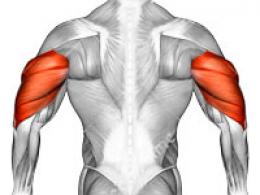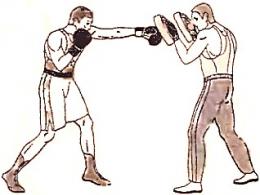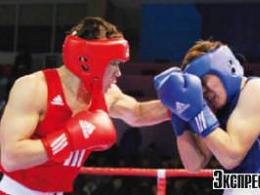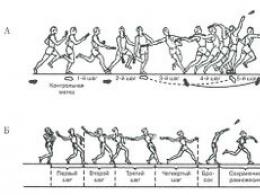Performing the French bench press, standing and sitting - with a barbell and dumbbells. Freaky pumping triceps on the French press
Master of all site and fitness trainer | more >>
Genus. 1984 Trained since 1999. Trained since 2007. CCM in powerlifting. Champion of Russia and the South of Russia according to AWPC. Champion of the Krasnodar Territory according to IPF. 1st category in weightlifting. 2-time winner of the championship of the Krasnodar Territory in t / a. Author of over 700 articles on fitness and amateur athleticism. Author and co-author of 5 books.
Place in : out of competition ()
Date of: 2012-05-29 Views: 256 333 Grade: 5.0
For what articles are given medals:
Additional- shoulder
Difficulty of execution- average
French bench press - video
Weight and reps for beginners
For men: 10 - 15 repetitions of 15 - 20 kg. 2 - 3 approaches.For women: 10 - 15 repetitions of 7 - 10 kg. 2 - 3 approaches.
Load on muscle groups
The load is indicated on a 10-point scale (the total load is summed up)Restrictions for injury/illness/pain
The degree of risk is indicated on a 10-point scaleDescription of the exercise
 Of all the French presses, this is perhaps the most dangerous. Point load on the elbows, with frequent use of this exercise, can injure them over time. It is better to lower the bar a little bit behind the head. I advise you to perform with a weight that you can do at least 10 times. And the exercise should be used for no longer than three months without a break.
Of all the French presses, this is perhaps the most dangerous. Point load on the elbows, with frequent use of this exercise, can injure them over time. It is better to lower the bar a little bit behind the head. I advise you to perform with a weight that you can do at least 10 times. And the exercise should be used for no longer than three months without a break. Main chips
1. The grip should be such that the distance between the hands is 20 - 30 cm. If you take it already, then the elbows will most likely diverge to the sides. In this case, the triceps will work worse. If you take it wider, then the movement for the joints will be less natural. Which is pretty traumatic. 2. A curved bar is better for this exercise than a straight bar. This, again, is due to the habitual and more comfortable movement in the joints. However, with a straight neck, this exercise can also be done. 3. Elbows should be as motionless as possible. In the standing version, this is much more difficult to do than lying down. Any movement in the elbows begins to involve additional muscles and reduces the load on the triceps. 4. You need to straighten your arms to the end. Bend too. But do it smoothly and do not throw the barbell down. 5. To perform the French bench press, it is not at all necessary to have a bench. It can be done on the floor with the same success. It's more convenient. Since you can just lie down and take the barbell. If you are doing it on a bench, then in no case do not take the barbell from the floor after you have laid down. Either take it and then lie down, or have someone give it to you.The French press is a great triceps exercise. It is recommended for men and women, can be performed in various variations. Some athletes do the French bench press while others are sitting, and still others are on an incline bench.
Some do the French bench press lying on an incline bench upside down. Moreover, in the process of work, you can use a barbell or dumbbells. All of these features make the French bench press a versatile strength exercise.
Technique
The French bench press differs from the classic one in the nature of the movements performed by the athlete. When performing the exercise, follow the French bench press technique:
- Take a seat on a horizontal bench;
- Ask the person insuring you to give the barbell or independently remove it from the supports;
- Take the neck so that the thumb grabs it from below, and the rest of the fingers from above;
- Raise the sports equipment, almost completely unbending your arms;
- Slowly bend your elbows, bringing the bar closer to the crown of the head (shoulders should remain motionless, and the angle of the elbow at the bottom point should be 90 degrees);
- Return to the original position.
If you want to work the triceps at the same time as the forearms, use a regular barbell. And to facilitate the seated French press, you can take the EZ-bar - it will take the load off the forearms.
The technique of the French bench press on an inclined bench will be similar. Only the starting position in this case should be such that the hands with the bar form a straight line with the body of the athlete. Moreover, you need to work on an inclined bench with less weight than on a horizontal one.
In order not to get injured while doing the French bench press on an incline bench, the choice of weight in general must be approached very seriously. It should be such that it is not difficult for you to follow the technique of the exercise.
It is also important to monitor the immobility of your shoulders - including them in work, you distribute the load incorrectly. The barbell French press is also a popular exercise option, pick what is comfortable for you.

In addition to triceps, you can also use the latissimus dorsi muscles when doing the French bench press. For this exercise is done from a sitting position. However, the correct technique is extremely important in this case.
It is necessary to sit on a bench, holding the barbell above your head with outstretched arms. As you inhale, bend your elbows and lower the bar behind your head. Then, as you exhale, return to the position you were in before. It is important that the elbows do not diverge to the sides - watch this.
You can even do the French press while standing. The technique will be almost the same as during seated workouts. And instead of a barbell, it is permissible to use dumbbells - one or two. This option is considered more preferable when it comes to performing the exercise from a standing position. With dumbbells, it's easier to work out, and besides, you can do it outside the gym.
In the field of bodybuilding, the French bench press is very popular among athletes. When it comes to working out the triceps, perhaps this is one of the most effective exercises. To perform characteristic movements, a whole complex of beams is involved here, which together form the triceps as a separate muscle. Let's just say that the French press is a basic exercise for the triceps, because it is able to fully load this part of the muscles.
The curves of the bar expose the arms at a natural angle to each other, thereby reducing stress on the forearms and hands. Along with this, the EZ bar is considered a projectile for beginners who are at the stage of mastering the technique. Professionals mostly use only a straight bar. One more piece of advice in conclusion: when doing a bench press with a narrow grip, you should not put your hands too close, the optimal distance is 10-13 cm. Otherwise, the elbows will be very difficult to hold, they will diverge to the sides, and the load will shift more to the chest, and not the triceps, which we are interested in.
Standing French Press
From an anatomical point of view, this type of bench press is considered the most successful solution. Here, the athlete does not limit his movements, so he can load the muscles more, respectively, the previous working weight can be increased. As a projectile for the exercise, use a barbell or dumbbells. They are often replaced with a barbell pancake. There is no particular importance in what is used, the main thing is to follow the correct technique.

The starting position is as follows: feet shoulder-width apart, shoulders and back straightened, a barbell or other projectile is held with a direct grip in the hands above the head, the distance between the hands may vary. On inspiration, the barbell is slowly lowered to the level of the forearms, on exhalation it is raised to the starting position. The working weight is selected in such a way that no more than 12-15 repetitions can be performed in one approach.
At first, before gaining a certain experience, it is recommended for beginners to do a bench press with one hand in order to “teach” the elbows to move in the correct amplitude. In this case, dumbbells are used, not a barbell. In the initial position, the projectile is held above the head with the hands of the palms forward. On inhalation, lowering is done until the forearms touch, and immediately on exhalation they are lifted up without observing a pause. The elbow joints throughout the set should be kept slightly bent, this will reduce the load on them. But slightly bent legs will ensure optimal coordination of movements.
Standing Dumbbell French Press
seated french press
The technique for performing this variation of the bench press is no different from the previous one, except that the legs are not involved here. The athlete is also not deprived of the range of motion. Features of the sitting position of the body served to the fact that athletes often make the same mistakes. Regardless of the projectile used, the back should be straight and slightly arched at the waist. At the slightest tilt forward, the shoulder joint and vertebral discs will have to suffer, since the load will shift on them.

Beginners need to practice the upright press more than this, standing is much easier to keep the torso. Despite the limited availability of information regarding the correctness of the bench press, athletes do not deprive themselves of the "pleasure" of making mistakes. Consequently, very often this behavior ends in injury to the elbow and shoulder joints. Until the moment when the technique is ideally studied, it is better to do the bench press with a belayer who will support the load if necessary. In the absence of such an opportunity, the bench press should be performed on a bench with special safety mounts. For beginners, the presence of a partner is necessary to follow the movement of the upper arm when lowering and raising the bar behind the head.
seated french press
Such mistakes of athletes as spreading the elbows to the sides, tilting the body, undoubtedly, have advantages, as they make the exercise easier. On the other hand, it only seems that the load from the triceps is transferred to the chest, shoulders, lower back. As a result, none of the muscle groups is subjected to optimal load, the exercise becomes completely ineffective. To prevent injury, before you start working with the French press, you need to thoroughly master the technique without the use of weights.
French bench press is a special exercise that helps to pump up the triceps. When they are performed, emphasis is immediately placed on 3 groups of triceps muscles. Therefore, the French bench press helps to quickly increase it and create a beautiful relief.
This type of exercise has many ways of performing. They can be done in different positions using different projectiles. The main thing is to do it right.
French Press Rules
These exercises put stress on the joints, so problems can arise with them. However, if you do the French bench correctly, then trouble can be avoided.
Here are the rules to follow when doing the exercises:
- Before starting classes, you should do a warm-up. This will help warm up the muscles and avoid sprains.
- Do not use too much projectile weight during classes. This can lead to joint problems and also cause muscle pain. It is better to take the minimum weight first and increase it over time.
All exercises must be done correctly. To know how to perform them, you should seek help from a trainer or carefully read this article.
French bench press technique
Barbell exercises.
To perform the French press in this position, you will need a barbell.
In addition, in this case, the hands are well located relative to each other. Therefore, for those who are just mastering this type of exercise, it is best to take a barbell with an ez-bar. If this is not available, then a simple projectile can be used.
Correctly doing the French bench press is as follows:
The French bench press is best done with a helper, even if you have chosen a light bar weight.
The fact is that such exercises are considered very traumatic, since one wrong movement can cause sprains, etc. At this moment, help will come in handy. If it is not possible to take someone as your partner, then perform the exercise on a projectile with a barbell stand so that you have the opportunity to fix it at any time.
Exercises with dumbbells.
French bench press in a horizontal position can also be performed with dumbbells. With it, you can achieve maximum load on the triceps and at the same time this type of exercise is less traumatic than the previous one. To properly perform a French bench press with dumbbells should be as follows:

In this case, the French bench press with dumbbells is performed in 3 sets of 15 repetitions.
Standing French Press
The standing French press is easier to do than the previous exercises. You can perform it with several types of shells - this is a barbell or dumbbells. The standing French press can be done with two hands or one hand.
Exercises with two hands.
In this case, the French bench press is performed while standing with a barbell. The technique will be like this. Stand up straight, take the bar in your hands with a direct grip, not a reverse grip, and stretch your arms above you. It should be noted that the distance between the palms should be slightly less than the width of the shoulders. They should be straight, so they should not be bent. After that, take them by the head. Try to touch your forearms with them. After that, immediately return your hands to the position in which you started the lesson. The recommended number of repetitions is 15-20. Starting the standing French press should be done with a light load. Gradually it can be increased.

Head exercises.
French bench press standing with one hand is recommended for beginners. The technique will be the same as in the previous exercise, but instead of a barbell, you need to use dumbbells. Take the projectile in one hand (grip from above) with a direct, not reverse grip and pull it above you. The legs are slightly bent at the knees. Move your hand behind your head, touch your forearm and return to the starting position. The number of repetitions is 15-20, after which the hand should be changed. The weight of the dumbbell should be light. Over time, it can be increased.

Exercises on the lower block.
This type of exercise is best done on a simulator with a rope handle. You need to perform the French bench press while standing on the lower block according to the following scheme:

French bench press on the lower block while standing will create a good load on the triceps. Thanks to this, you can quickly achieve a good result.
seated french press
The seated French press can be done with a barbell, 1 dumbbell, and 2 dumbbells. In each case, the load goes to the triceps.
Barbell exercises.
French bench press with a barbell in a sitting position is recommended to be performed according to the following scheme:

Exercises with 1 dumbbell.
The dumbbell french press has the following execution technique:

Exercises with 2 dumbbells.
French press with dumbbells in a sitting position should be done like this:








